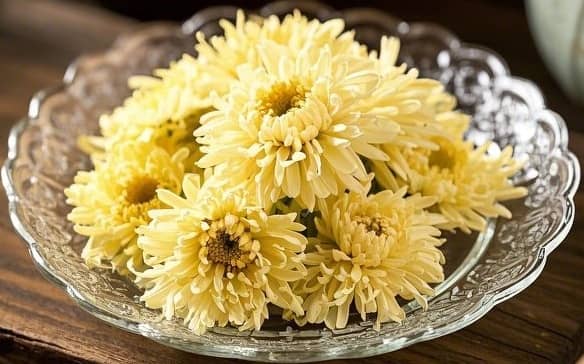Today, let’s talk about the unique charm of chrysanthemum. Chrysanthemum, the dried flower heads of the Chrysanthemum plant, not only has practical medicinal value but also carries rich spiritual symbolism. It embodies both the delicate beauty of peach blossoms and the steadfastness of pine trees, earning it the title of “the Gentleman of Flowers,” and it is also one of the “Four Elegance” of flowers.

Since Tao Yuanming wrote “Plucking chrysanthemums by the eastern fence, I gaze upon the southern mountain,” chrysanthemums have come to symbolize the “hermit flower,” like a wise sage quietly blooming in a secluded corner away from the hustle and bustle of the world.
Table of Contents
- Medicinal Value of Chrysanthemum
- Chrysanthemum as a Symbol of Spirituality
- Varieties of Chrysanthemum and Their Effects
1. Medicinal Value of Chrysanthemum
In Traditional Chinese Medicine (TCM), chrysanthemum is spicy, sweet, and bitter, with a slightly cold nature, and it primarily targets the lung and liver meridians. Its benefits include dispersing wind-heat, calming liver yang, clearing liver heat and improving vision, and detoxifying. Chrysanthemum is known as the “Longevity Herb,” and it is listed as a superior herb in the “Shennong Bencao Jing.” It is recorded to treat dizziness, swelling, and eye problems, as well as benefiting blood circulation and prolonging life.
Due to its remarkable effects, chrysanthemum has long been associated with longevity. The famous writer Fu Xuan from the Jin Dynasty praised it in the “Chrysanthemum Rhapsody” by saying, “Those who take it live long lives, those who eat it are enlightened.” This is a highly respectful endorsement of its medicinal properties.
2. Chrysanthemum as a Symbol of Spirituality
Beyond its medicinal uses, chrysanthemum also symbolizes high character. Since Tao Yuanming’s verses, it has come to represent a life of simplicity and wisdom, away from worldly distractions. Chrysanthemum is seen as the “gentleman” of flowers, embodying resilience and purity. It thrives in autumn and is admired for its ability to bloom despite the changing seasons.
3. Varieties of Chrysanthemum and Their Effects
Chrysanthemum has many varieties, each with its own medicinal properties. For instance:
- Chuzhou Chrysanthemum: Also known as “White Chrysanthemum” or “Sweet Chrysanthemum,” it is one of the “Four Major Medicinal Chrysanthemums.” It has tightly packed petals with a golden center and crystal-clear white petals, known as “Five Petals of Golden Heart.” This variety is especially effective in calming liver yang and is often used to treat symptoms such as dizziness and eye strain caused by excessive liver yang. Hypertension patients with liver yang excess can use Chuzhou Chrysanthemum with cassia seeds as a tea. “Bencao Gaimu” records that using Chuzhou Chrysanthemum as a herbal pillow can help with liver yang excess.
- Bozhou Chrysanthemum: Mainly grown in Bozhou, Anhui Province, this variety has loose petals that easily open. It is known for its wind-dispelling, heat-clearing, and vision-improving effects, particularly useful in spring and summer. Bozhou Chrysanthemum can be made into herbal pillows for restful sleep and used with rice to make porridge, helping to prevent heatstroke during the summer.
✅ Conclusion
Chrysanthemum is not only a beautiful flower but also a medicinal herb with rich healing properties. Different varieties of chrysanthemum have unique therapeutic effects, whether it’s Chuzhou Chrysanthemum’s liver-calming properties or Bozhou Chrysanthemum’s cooling effects. These varieties can play an important role in maintaining good health in our daily lives. Stay tuned for the next installment where we’ll continue exploring other chrysanthemum varieties and their uses!